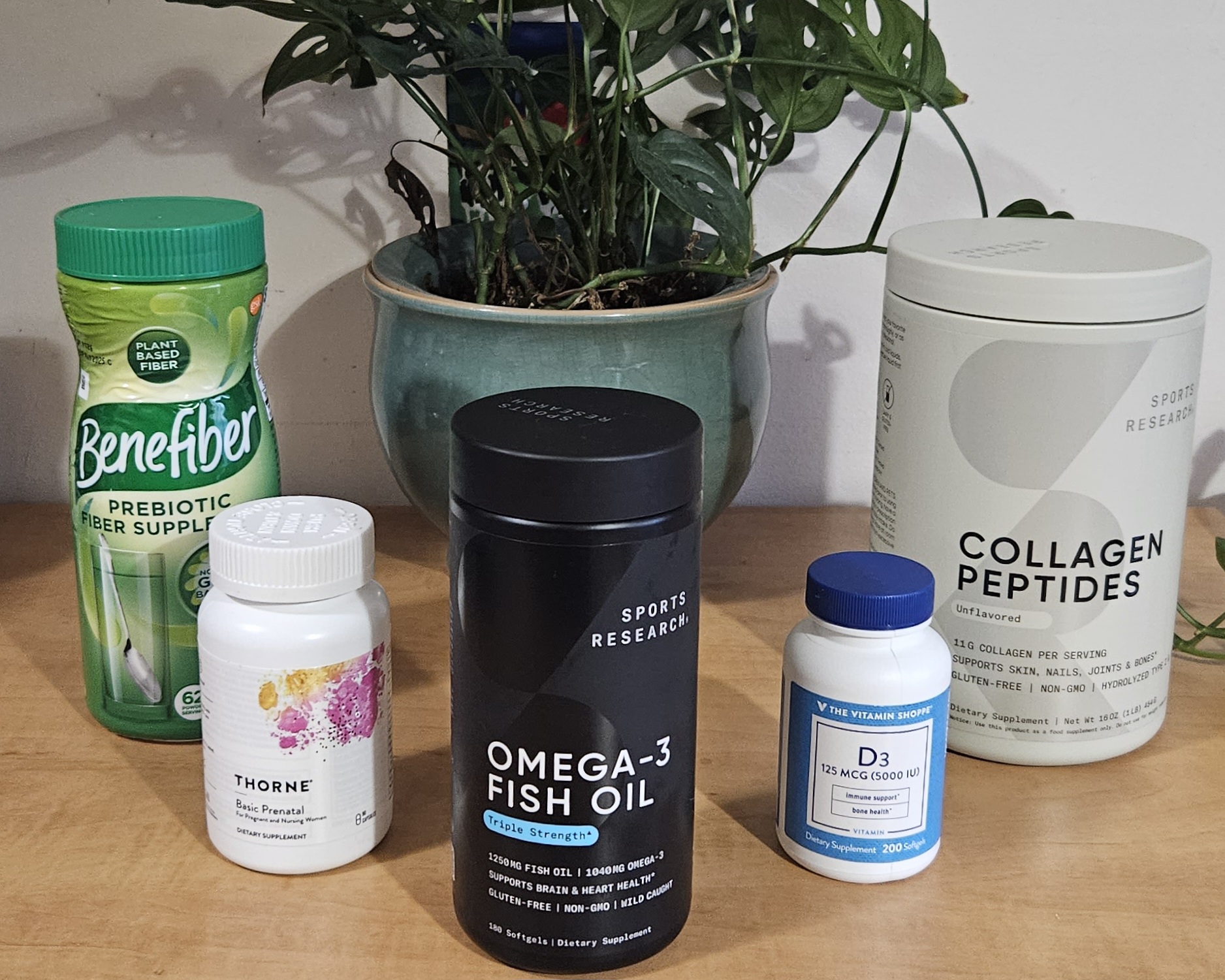I have become a firm believer that having a supplement routine is beneficial for my overall health. I still think the majority of our daily nutrients should come from food, but supplements are great for filling in the gaps where food just isn’t enough. That being said, supplementing is highly individual. The decision to add supplements to your diet is one that you should make for yourself and with input from your doctor. I want to be clear that I’m not a doctor and I’m not trying to give advice with this post. I simply want to share the supplement routine I follow and why.
Some of the links in this post are affiliate links, but the opinions are 100% my own.
Somehow a post about the five things I take got really long! If you would prefer a TLDR, here it is:
Thorne Basic Prenatal

Why Add This to My Supplement Routine?
I started taking a prenatal when I decided to end my birth control in order to have my first child. (The recommendation is to start taking the prenatal before conceiving, if possible.) I am sure I just went to Target and bought whatever looked good at that time. Once I actually did get pregnant, though, I became more concerned with the quality of the supplement I was taking. I asked my doctor what she thought the best prenatal vitamin was, and she gave me the least satisfying answer possible.
“Any. They’re all the same.”
Um, no.
The doctor gave me a bag of samples, so I had time to consider what I wanted while I worked through those. I compared many of the ingredients to find that they were vastly different from one another. I think there may be some value there – I was certainly getting a variety by taking all of the samples – but it also highlights that many of these options had significant gaps.
How I Chose a Brand
At the same time, I started listening to Dr. Rhonda Patrick, first being interviewed, then directly on her podcast, Found My Fitness. I specifically focused on the episodes where she talked about her pregnancy. I really trust her voice as a scientist (she has a Ph.D. in biology and a strong focus on nutrition). But I also found a kindred in her somewhat neurotic personality, and I mean that as a compliment! I knew she was serious about what was best for her baby, and that was the advice I wanted. And with zero sponsorship or kickbacks, she said she trusted Thorne.
With that vote of confidence, I ordered it. When it arrived, I compared the ingredients with the others I had been taking and found it exceeded them in nearly every category. What’s more, I believe that the quality is as good as they say it is. They are careful with their ingredient sourcing to keep contaminants out and purity high. They also work to use the most bioavailable forms of each compound. Another of my intellectual role models, Andrew Huberman, has also stated his confidence in this brand. This only lends further credibility to the brand in my mind.
Dosage and Other Thoughts
This one is easy — I just take the recommended dose. That is three capsules, which could really suck for people who have a hard time taking pills, but I don’t.
The pregnancy that started this ended in a healthy birth in April of 2022, but I have continued to take this for well over a year after that. There are a few reasons for this. First, I am still breastfeeding, and prenatal vitamins are recommended throughout that whole process. They help cover the nutrient gaps for both mom and baby. Second, I want to get pregnant again relatively soon. I can’t say exactly when, but that goes back to the recommendation I mentioned above. And third, it’s just a good multivitamin. I have a friend who is a paramedic, and she takes a prenatal as her multi even though she never intends to get pregnant. To my knowledge, she does not necessarily take this brand, but the idea is the same. She simply appreciates the quality and value of it as a daily vitamin.
Omega-3 Fatty Acids

Why Add This to My Supplement Routine?
I was instructed to take a six-month course of a specific, high-dose Omega-3 supplement when I had laser eye surgery in 2021 (PRN Dry Eye Omega). It actually ended up taking me about eight months to take them all, since I am human and forgot to take them some days. By about the middle of this course, I was pregnant. DHA, one type of Omega-3, is highly recommended for pregnancy. On top of that, there is no known negative effect of the other types (EPA and ALA), so I didn’t worry about taking a high dose of fish oil while pregnant. (Fish oil is the most common source of Omega-3s in supplement form.) (Read my whole post about omega-3 fatty acids here!) Once I was finished with the PRN, though, I switched to a prenatal DHA because the other seemed like overkill.
My mood tanked.
I switched back to a full Omega-3 supplement, and like magic, I was back to happy. Looking back on the whole pregnancy and postpartum period, I really didn’t have significant mood swings or the typical forgetfulness that is associated with “mommy brain”. I attribute most if not all of that to the Omega-3s. At the same time, I was listening to Dr. Rhonda Patrick (as mentioned above), and started to learn so many more benefits of Omega-3s, not just in pregnancy or for my eyes, but for my whole body. Omega-3s are thought to help with learning, memory, and mood, decrease the risk of dementia, decrease the risk of heart disease (the leading cause of death in the USA), reduce inflammation which can relieve things like arthritis, and so much more. Now, not all of this applies directly to me, but none of it hurts!
How I Chose a Brand
While PRN’s quality was top-notch, it was also very expensive, so I looked around for another brand. Fish oil is great because it actually has its own certifying body – IFOS (International Fish Oil Standards) – that tests for potency and quality. Their website is full of information on many different brands, and I have used this tool to guide my choices. Right off the bat, I rule out anything that gets low marks for contaminants or purity.
Before I even check the quality of a brand, though, I look for the form the Omega-3s come in. The two main options are Ethyl Ester or Trygliceride, and I always go with Trygliceride. It is more bio-available, so I should be able to absorb more of the actual nutrients from the supplements in this form. Unfortunately, it is also typically more expensive.
After that, I look at the strength. I take a high dose, so I want each capsule to be as concentrated as possible so I can take as few as possible. There are also oil options that are not in pill form, but I don’t prefer those. The gummies are often not as high of a dose and more expensive than the pills. That being said, I buy the Nordic Naturals Sugar-Free Gummies for my 11-year-old. They are top quality, and while they are a lower dose than I want for myself he doesn’t need as much. More importantly, I can actually get him to take them.
For myself, I feel you can’t go wrong with Nordic Naturals Ultimate Omega 2X, but I have found other, less expensive options that are just as good. The two that I have tried and liked are Sports Research Triple Strength Omega-3 Fish Oil and Viva Naturals Triple Strength Omega-3 Fish Oil.
Dosage and Other Thoughts
As I mentioned above, I take a lot. My goal is to get about 3 grams every day, with about 2 grams of that as EPA and close to 1 gram DHA. This is also based on information I have gathered by listening to Dr. Rhonda Patrick and Dr. Andrew Huberman, plus the people they interview on their podcasts. It seems for me those levels, especially of EPA, are where I really get the mental benefits.
In order to get that amount, I take three pills of any of the three brands I mentioned above. When looking at the nutrition facts to determine potency, it is crucial that you look at what they call a serving. For example, both Nordic Naturals and Viva Naturals say they have over 2,000 mg (which is 2 grams) per serving, but a serving is two capsules. Sports Research only has just over 1,000 mg per serving, but their serving is one capsule. What this means is that, per pill, they are roughly the same. I always look at the dosage per pill, then determine on my own how much I want to take.
Vitamin D3

Why Add This to My Supplement Routine?
Simply put, Dr. Rhonda Patrick convinced me. I didn’t think much about vitamin D; if you had asked me before I would’ve guessed I was getting enough. After all, I take a prenatal, drink fortified milk, and sometimes see the sunshine on my skin.
It turns out around 40% of people are at sub-par levels of vitamin D, and 30% are actually deficient. Also, vitamin D is more like a precursor to a hormone. It controls gene expression, has benefits to mental health, and being deficient is linked to higher cancer risks. Basically, being low on it seems exceptionally bad to me. (Check out this infographic for more on that!)
How I Chose a Brand
Admittedly, I am far less picky about the brand of this one. I just want to make sure it is a trusted source and has a high enough potency. Most commonly I buy Nature Made, but Thorne and Sports Research have good ones, too. Sometimes you can find fish oil that already has it, or a multivitamin that supplies enough.
Dosage and Other Thoughts
I take 5,000 IU of vitamin D3 as a part of my supplement routine every day. This is very high when compared to the current Recommended Dietary Allowance (RDA) of 600 IU, and actually higher than the Tolerable Upper Limit of 4,000 IU. Unlike water soluble vitamins like Vitamin C, there is a risk of overdoing Vitamin D, but I think that risk is at doses well beyond what I am taking.
I am of the belief that the RDA has not caught up to the newest data, based on D. Rhonda Patrick’s research. What I gather is that toxicity becomes a concern with daily doses of 10,000 IU or above, and I’m at half of that. Not to mention there are days I forget to take my supplements at all, so I am still covering those gaps as I go. And more important than any of that is what my bloodwork has shown, which is that I am not overdoing it.
Collagen Powder

Why Add This to My Supplement Routine?
I take collagen because I am optimistic that it may have positive benefits on my skin, hair, nails, and joints. I can’t say that I have noticed a direct effect on any of these things, but I didn’t have many complaints about them before. Even if the benefits to those systems are overstated, though, I still really value the added protein. I am constantly looking to add more protein to my diet, and while I think it would be ideal to get it from food, adding it to my supplement routine can help with that, too.
How I Chose a Brand
In this case, I already trusted Sports Research from looking into their Omega-3 supplements, so I was happy to stick with that. Just like with the vitamin D3, I am not married to this brand. I am open to any quality brand that has a similar profile (i.e. calories and collagen per serving without impurities), this is simply what I have found that works.
Dosage and Other Thoughts
I put a scoop of unflavored collagen in my coffee every morning, which is 10 grams. Admittedly, it isn’t my favorite flavor profile to add, but I find it tolerable. I should note, though, that I take my coffee black. It has a bit of a sweet taste to me, so it would probably blend in more with some cream and/or sugar.
Benefiber

Why Add This to My Supplement Routine?
We are headed straight for some TMI here. After pushing for four hours during the birth of my daughter, I ended up with hemorrhoids that lasted over eight months. The OB prescribed me a cream, but it was not effective. I told my GP about it at a routine checkup, and she recommended I take Benefiber. She also sent me to a specialist to ensure nothing more was wrong, but over a short time, the Benefiber took care of it. (And the specialist found nothing else!)
This sent me on a bit of a journey of discovery regarding fiber, and I found it has so many more benefits than I realized! Fiber can help lower LDL cholesterol (“bad” cholesterol), aid in digestion, help you feel more full, and help regulate blood sugar levels. Benefiber is also a prebiotic fiber, so it promotes healthy gut bacteria.
Like anything else, I’d prefer to get all of my fiber from food, but that is easier said than done. Many foods in our standard American diet that should contain fiber have had it processed out (think bread). I still get a good bit of fiber from whole foods such as fruit, veggies, and legumes, but most days I don’t get the RDA of 25 grams. You can’t easily overdo fiber, so I like to add it to my supplement routine as well.
How I Chose a Brand
I bought Benefiber because it was the specific recommendation of my doctor. I don’t think it is necessarily a higher quality fiber than other brands, but I did switch to a generic once (Target brand) and I felt like the granules were larger and it didn’t dissolve as well. After that, I decided to just stick with Benefiber. It’s not a huge price difference, and it’s not like I am buying a new bottle every week.
Dosage and Other Thoughts
Just like the collagen powder, I add this to my coffee every morning. I am the least precise with dosage of this one; I just add a heaping spoonful and stir it in. I figure it isn’t critical that I know exactly how much I am getting, just that I am getting extra. And I still try to boost my dietary fiber at every opportunity. One of my favorite ways is to meal prep with my Black Beans and Corn Salad. Occasionally, I will also take capsules of Glucomannan to boost fiber even further and help me feel full. That is not part of my daily supplement routine, though, just something I do from time to time.
So that’s it! I would love to know if you take any of the same. Even better, what would you add to my supplement routine?








2 responses to “The Powerful Daily Supplement Routine that Works for Me”
[…] Mood: okay, this is kind of just brain again, but research suggests that omega-3s play a role in regulating mood and alleviating symptoms of depression and anxiety. (This was the benefit I noticed that keeps me taking it every day!) […]
We use that same collagen supplement in our house! We do the same – 1 scoop in our coffees, but yes we take ours with flavored cream and I think the subtle sweetness enhances the flavor. Yum! Great read!!